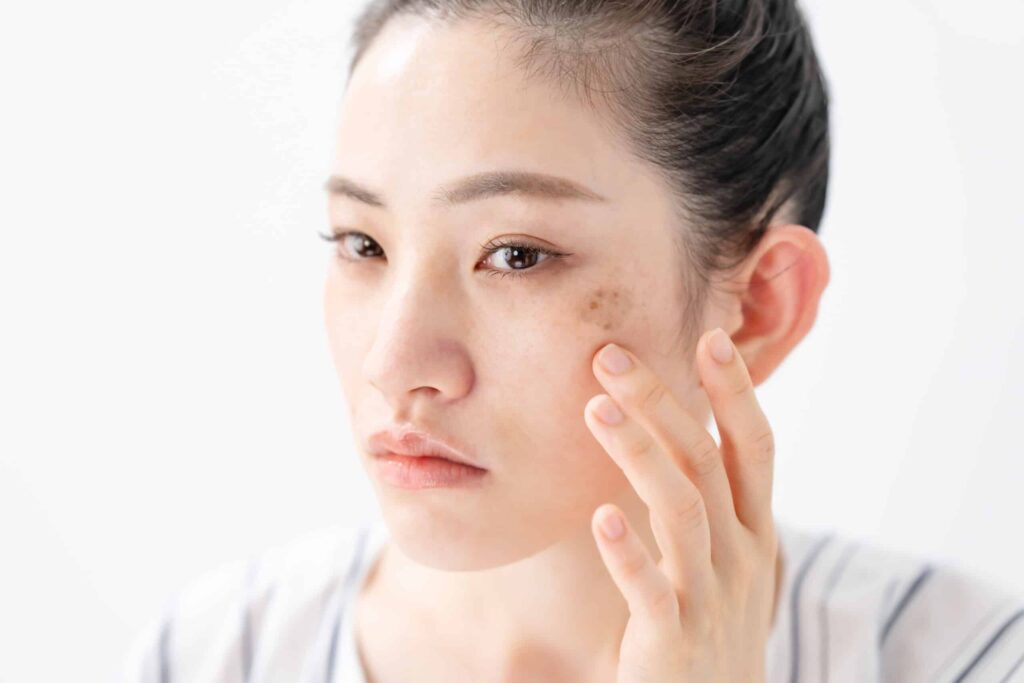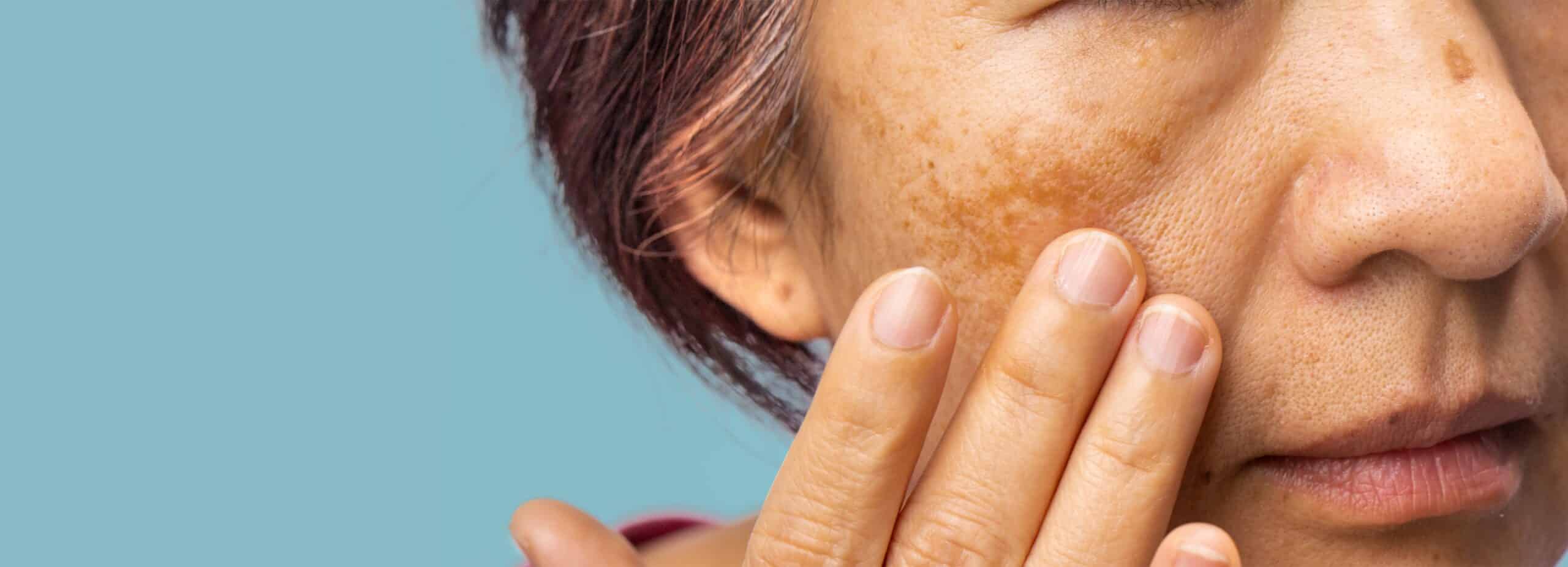
Here’s How Oral Tranexamic Acid and Cyklokrapon Injections Helps to treat Melasma
- September 23, 2022


Melasma is a prevalent skin condition that causes dark-coloured spots and patches to develop on the skin, most commonly on the face. It is a chronic condition which can affect people of all skin types. However, it is prevalent in Asia, given the larger proportion of individuals with darker skin tones. Due to the higher levels of melanin in Asian skin, melasma can be more conspicuous and difficult to treat.
People with melasma may suffer both emotionally and physically. The unsightly pigmented patches on the skin may be distressing, causing sufferers to feel self-conscious and embarrassed. The affected areas may also feel rough, causing sufferers to experience physical discomforts such as itch, dryness or burning sensations.
Given the significant impact that melasma can have on an individual’s quality of life, it is crucial to have a better understanding of the condition and the treatment options available. Through research, clinical findings and extensive experience, SL Aesthetic Clinic has developed effective strategies for managing melasma in Asian skin. More will be discussed in this article.

The exact cause of melasma is not fully understood, but it is believed to be a combination of various factors. Melasma can affect anyone, but it is more common in individuals with darker skin types (Fitzpatrick skin type III–VI), including those of Asian, Middle Eastern, Latin American, and African descent. A study of 205 melasma patients in Singapore revealed a female-to-male ratio of 21:1. Women tend to be more susceptible than men as the condition is often associated with hormonal changes, including pregnancy, oral contraceptive use, and hormone therapies.
Other factors that may increase the risk of developing melasma include:
Exposure to the Sun: Ultraviolet (UV) from the sun can trigger the production of melanin in the skin, which can lead to the development of melasma. People who spend much time in the sun or have a history of sunburns are more likely to develop the condition.
Genetics: There may be a genetic component to melasma, as the condition has been observed to run in families.
Skin trauma: In some cases, melasma may develop following skin trauma, such as chemical peel, laser treatment, or other forms of skin irritation.
Cosmetics and skincare products: Certain cosmetics and skin care products can irritate the skin and trigger the development of melasma. This tends to be more common in individuals with sensitive skin or those allergic to certain ingredients.
Tranexamic acid, sometimes also referred to as “TXA”, is a medication commonly used to treat excessive bleeding in various medical conditions, including surgery, trauma, and menstruation. It blocks the breakdown of blood clots, which can help to prevent or reduce bleeding.
In low doses, tranexamic acid can be used as pigmentation/melasma treatment. It has been shown to have a brightening effect and also reduce the appearance of dark spots and skin pigmentation. This could be attributed to its ability to block the production of melanin, the pigment responsible for skin color.
TXA injections are sometimes used interchangeably with Cyklokapron injections, as tranexamic acid is the active ingredient in Cyklokapron.

Tranexamic acid is a synthetic form of the amino acid lysine. In the context of melasma, it is thought that TXA works by inhibiting the activity of plasmin in the skin (an enzymes that breaks down blood clots), which leads to a decrease in the production and activity of melanin, a dark-coloured pigment in the skin.
Melanin is produced by melanocytes, cells located in the outermost layer of the skin. An overactivity of melanocytes in melasma is what causes excess melanin or pigmentation problems in certain areas of the skin.
Tranexamic acid can be administered in various ways to treat melasma:
Oral tranexamic acid has been studied extensively in Asia to treat melasma and has shown promising results. In a Singapore study involving 561 patients, a vast majority of 89.7% reported an improvement after a four month course of oral tranexamic acid. Another study in China derived a similar positive conclusion. Side effects were minor, with 5% experiencing gastrointestinal discomfort and 8% reporting hypomenorrhea (extremely light menstrual blood flow).
However, it is important to note that oral tranexamic acid should be used under the guidance of a healthcare provider and may not be suitable for everyone.
Oral tranexamic acid can be an effective treatment option for melasma, but not everyone is a good candidate for this type of treatment. Here are some factors to consider when determining whether someone is a good candidate for oral tranexamic treatment:
Diagnosis of Melasma: Oral tranexamic acid treatment is typically reserved for patients who have been diagnosed with melasma by a dermatologist or other qualified healthcare provider. Melasma is a condition that causes brown or grey-brown patches to appear on the skin, and is often caused by hormonal imbalances, sun exposure, or other factors.
Severity of Melasma: Oral tranexamic acid treatment may be more effective for patients with moderate to severe melasma rather than mild cases. It is important to discuss the severity of the melasma with a healthcare provider to determine the best treatment options.
Overall Health: Patients should be in good overall health and free from any conditions that may contraindicate the use of oral tranexamic acid. It is important to discuss any medical conditions or medications with a healthcare provider prior to starting oral tranexamic acid treatment.
Pregnancy and Breastfeeding: Women who are pregnant or breastfeeding should not use oral tranexamic acid, as the effects of the medication on the fetus or newborn are not well understood.
Compliance: Oral tranexamic acid treatment requires strict compliance with the dosing schedule in order to be effective. Patients who are not able to adhere to the recommended dosing schedule may not be good candidates for this treatment.
In summary, a good candidate for oral tranexamic acid treatment for melasma is typically someone who has been diagnosed with moderate to severe melasma, is in good overall health, and is able to comply with the recommended dosing schedule. It is important to discuss any medical conditions or medications with a healthcare provider to determine whether oral TXA treatment is appropriate for an individual patient.
The length of time that it takes for oral tranexamic acid to help improve melasma can vary depending on a various factors, including
In general, it can take several weeks or even months for oral tranexamic acid to produce noticeable results in the treatment of melasma.
At SL Aesthetic Clinic, our doctors usually prescribe a customised treatment based on an individual’s diagnosis and lifestyle habits. In addition to oral tranexamic acid, the treatment plan may include topical treatments, Pico laser or radiofrequency microneedling (e.g. Sylfirm X, Secret RF, Morpheus 8) to reduce pigmentation.
It is also important to note that results can vary greatly from individual to individual, as everyone’s skin reacts differently to treatment. Some individuals may see significant improvement in their melasma within a few weeks of starting treatment with oral tranexamic acid, while others may take several months to see results.
In order to maximize the chances of seeing results from oral tranexamic acid in the treatment of melasma, it is important to follow your melasma treatment plan consistently. Regular follow-up appointments with your aesthetic doctor can track your progress and make any necessary adjustments to your treatment plan.
Oral tranexamic acid can be obtained in Singapore with a prescription from a licensed healthcare provider. This medication is typically available at retail pharmacies, including both independent and chain pharmacies, as well as at clinics.
If you are considering oral tranexamic acid to treat melasma, you should should first consult with a dermatologist or aesthetic doctor. After a thorough evaluation, your doctor will then decide if oral tranexamic acid is suitable to be part of your melasma treatment plan.
When dealing with melasma, professionalism and experience are required for safe and effective treatment. Therefore, patients who wish to receive treatment for melasma should undergo a detailed examination by a qualified doctor, who will then arrive at a suitable treatment option based on the patient’s skin type and budget.
If you are tired of seeing melasma on your face in the mirror every morning, SL Aesthetic Clinic has the clinical expertise to provide the necessary diagnosis and treatment to alleviate the condition. Call us at 6235 3246, or Whatsapp us at 9850 7112.
Like what you read? Share them!